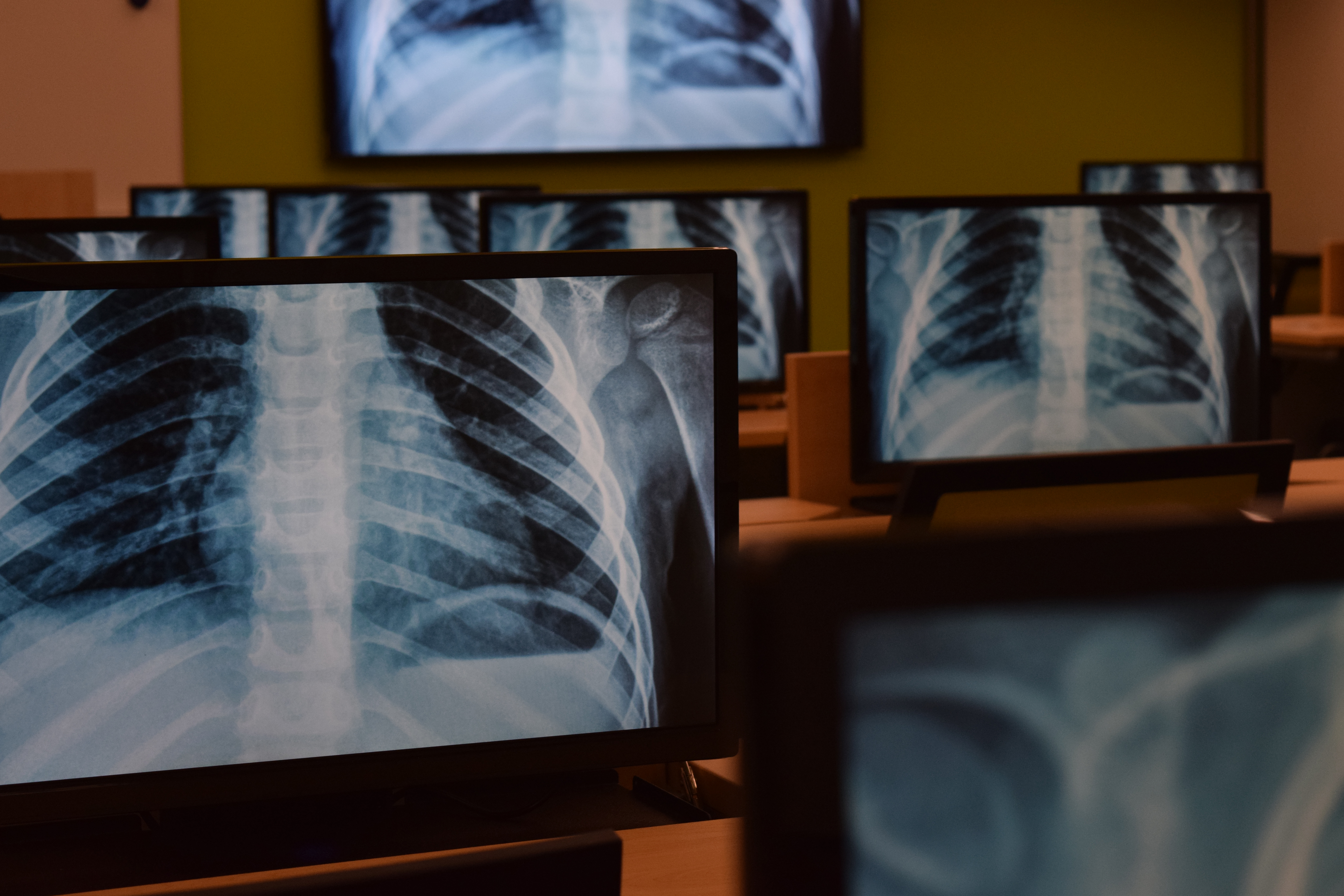“Six Million Dollar Man: Better…stronger…faster.” But what about the AV-enabled human? We know that AV can empower students in active learning classrooms and thrill fans at Yankee Stadium, but audiovisual innovations can also improve our health. From live streaming operations to teledental diagnoses, more institutions are leveraging the power of AV to improve services. Not all healthcare tech trends are generating the same excitement, however. Artificial intelligence (AI), telehealth, and personalization are inspiring new healthcare AV designs.
Artificial Intelligence Can Make Healthcare AV Smarter
According to The Sextant Group’s systems designer, David K. Glenn, RCDD, CTS-D, LEED AP BD+C, the big buzz in healthcare technology in 2018 is around artificial intelligence (AI).

AI integrations are being explored—and deployed—in about every commercial industry. Gartner Research suggests that the global business value derived from artificial intelligence is projected to total $1.2 trillion in 2018, an increase of 70 percent from 2017. AI-derived business value is forecast to reach $3.9 trillion in 2022.
While the healthcare industry is relatively slow to adopt new technologies like AI, in part, to regulation and HIPPA compliance, not to mention the hefty price tags, healthcare providers need to stay current to meet evolving patient expectations. Right now, a consumer can yell “Alexa!” and the digital assistant will activate connected audio, video, and digital operations in a house. This AI-enabled, instant access paradigm that we expect in a car or home is fundamental to Gen Z—the personalization generation. Pew Research data from 2018 reveals that the “share of Americans that own smartphones is now 77 percent.” One of the goals of AI-enhanced digital assistants in healthcare is to give doctors and providers more time to spend with patients.
The digital patient trend is also being fueled by wearable technology trends. Data sets logged from wearables and similar consumer devices can be powerful tools for providers, showing a “big picture of big data,” Glenn said. Proper analysis is important to ascertain the real story of the data, but over a period of time, metrics such as exercise, sleep habits, and blood sugar levels can help providers customize better care delivery plans targeted to specific patient needs.
Glenn pointed to Fitbit’s ubiquity and the skyrocketing interest in smartphone-connected health devices, such as the smart EKG Kardia Mobile app by AlivCor. As mobility usage grows, we should see an increased demand for mobile healthcare apps.
Augmented Reality (AR) and Virtual Reality (VR) are also expected to make more in-roads in the Medical Simulation field in the near future.
Telemedicine Trends
Telemedicine is a broad term referring to the telecommunication strategies and real-time collaboration technologies that provide clinical healthcare information from a distance. Within the telemedicine category are subcategories such as virtual health, telehealth, teledental, telepsychology, telestroke, and e-ICUs, an application in which many larger hospital systems are investing. Imagine real patient monitoring and doing “virtual rounds” via robust video technology and IP-based video systems built into patient rooms.
Glenn confirms that the telemedicine category is diverse: “It can be simple [or complex]. Think of a local Walgreens or CVS that offers a remote consult with a doctor. You can talk to a doctor for smaller, acute problems through your smartphone. It's like ‘doctors on demand.’” Some states are creating telehealth programs where patients can virtually consult with doctors quickly and instantly, and have that call covered by insurance. At the very least, telemedicine technologies are expanding the reach of healthcare providers large and small.

Pete McLain, SVP of Healthcare, Yorktel, explained that among Yorktel’s many specialties in healthcare AV are telemedicine-as-a-service and in-patient solutions for telestroke and behavioral health. With a telestroke system, a stroke patient who must receive treatment within about a three-hour window can be evaluated virtually by a neurologist.
As soon as the patient is present in the emergency department, a neurologist can be brought in via high-definition camera system to make a qualified assessment.
The telestroke systems have been “a game changer,” McLain said. “That's really helped with rural areas where they don't have neurologists [on staff]. Even in urban areas, with ambulance rides, the travel to get physically across town can consume that critical three-hour window.”
Digital Patients Demand Technology-Rich Experiences
From smart EKG apps to hospital directory apps equipped connected to Bluetooth beacon, there are so many new products coming to market right now that Millennials and digitally driven consumers are buying and using, but who knows how to pull them all together? That’s a key takeaway for AV integrators, designers, and consultants. The healthcare providers of tomorrow will need more inclusive designs. Think about robust but flexible solutions that are API-friendly and can help providers tie disparate apps and touch-points together coherently.
One example of this kind of flexible yet customizable system is Yorktel’s Univago HE telehealth-as-a-service platform. Specifically designed for healthcare, Univago HE delivers everything healthcare facilities need to video-connect patients with clinicians, healthcare experts, client teams, and family members. Users can leverage a single video platform across multiple telemedicine workflows. Univago HE includes all managed services, software, licenses, monitoring, diagnostics, reporting and hardware with no add-ons. Available APIs and SDKs allow the platform to integrate video with a wide variety of healthcare applications. Ongoing service and support are included, too.
McLain also noted the growing importance of cloud-based solutions, including systems with enhanced management capabilities and proactive monitoring. But he warned: “If you're going to put AV equipment into critical environments, it's got to work. It has to be highly reliable.”
Medical Students Demand Technology-Rich Learning
As reported in AV Technology earlier this year, UNLV School of Medicine’s Virtual Anatomy Lab exemplifies the next-level of medical educational design. The Virtual Anatomy Lab is outfitted with 36 student stations, with two students to a station, in an active-learning style. “The histology instructors were driving the content, and we came up with a 4K solution that we had to spread out to 70 students,” said Frank Alaimo, AV systems specialist, CTS-I, DMC-E-4K, Classroom Technology Services at UNLV.

In this remarkable lab, there are 37 bezel-free Planar IX2850 28-inch 4K monitors that stow in custom tables made by Computer Comforts. Two 98-inch Planar UltraRes UR9851 Ultra HD 500-nit LCD displays flank the whiteboard on the front wall behind the Middle Atlantic L5 Lectern instructor station. Sonic Foundry’s Mediasite RL 720 and a Vaddio RoboSHOT 12 provide HD room capture and magnification. Crestron’s Digital Media 4K family of products are used throughout. Audio processing is handled with Biamp’s TesiraFORTÉ AI, a Crown DCi series amplifier, four JBL Control high-output speakers, and Listen Technologies LA0-140 used for assistive listening.
HIPPA Compliance
AV and UCC technologies for use in healthcare installations must be verified and compliant with the Health Insurance Portability and Accountability Act of 1996 (HIPAA) for patient privacy and verified. Patient information and related multimedia content must be fully encrypted with secure logins and authentication required. Yorktel’s Univago’s HE platform offers those protections as well as ISO 27001 certification for the security of information assets. It’s also hosted in hardened SOC2-certified data centers for an extra level of security.
While many of the popular applications out right now certified and compliant. Where Glenn sees some uncertainty are the consumer wearable devices. “How does that information get stored locally in your mobile device, in your homes?” he asked. “And how does that transfer to your primary care provider, and how does that get integrated into your electronic health record? That is the big challenge [regarding] HIPPA.”
Technology is Changing Delivery Methods
As mobile usage and telemedicine projects increase, many state and private medical institutions are evaluating the size and scale of new in-patient facilities. How many beds will be needed in hospitals due to open in 2022? Glenn sees the delivery of care changing, and he believes that telemedicine is creating efficiencies. There is a notable shift toward more ambulatory care facilities rather than large-scale complexes. “We are seeing less [of the larger centers] and more ambulatory facilities because providers are trying to offer a higher level of care at a lower cost. Technology is helping that.”
Pertinent Standard: TIA-1179
What should systems integrators know about standards and so-called “future-proofing?” Look to the BICSI TIA-1179 (Telecommunications Industry Association’s—TIA) cabling standard for healthcare facilities. It underscores the importance of a robust infrastructure for new devices producing heavy amounts of data. A minimum category 6A cabling is specified for use in the horizontal and backbone cabling systems.
Invest in the Network and Networked AV
When it comes to networked AV in healthcare facilities, it’s not even a question of it being advantageous. Many believe AV on the network is a necessity. The convergence of data-heavy healthcare technologies requires a robust network infrastructure, however. MRIs, for example, are heavy to transport, but on a 10 Gb network, MRIs could travel in seconds. Large academic university medical centers seem to be on board, though smaller community hospitals face restrictions where IT budgets are tighter.
It’s All About the Experience
For AV integrators, designers, and consultants, it is important to open the aperture, Glenn argues. “We can't really restrict what we do to just AV. It’s all about the patient experience.” The rebranding of InfoComm into AVIXA, the Audiovisual Integrated Experience Association, emphasized that experiences matter, and there is a value in the art and science of integrated experiences. Beyond installing AV components, think about how to enhance the user experience—the patient experience. “That's really what we strive to do,” Glenn said, “find out what are the business operation goals are of the hospital, and ask how do we drive that patient experience? How do we improve their work flow operations?”
It’s time to get creative. Smart strategies will be needed for high-tech and flexible AV solutions that comply with state regulations and insurance requirements. AV professionals can be key influencers in the next stage of healthcare technology, crafting the future of dynamic medical services and education.

